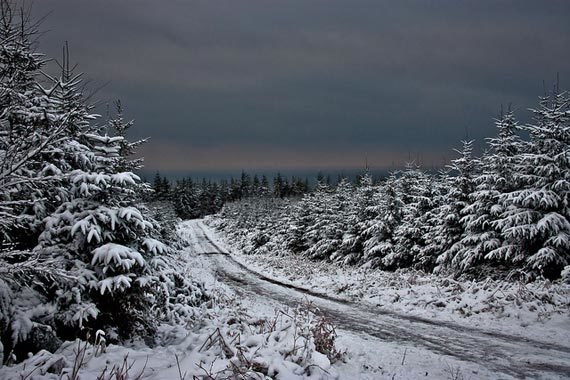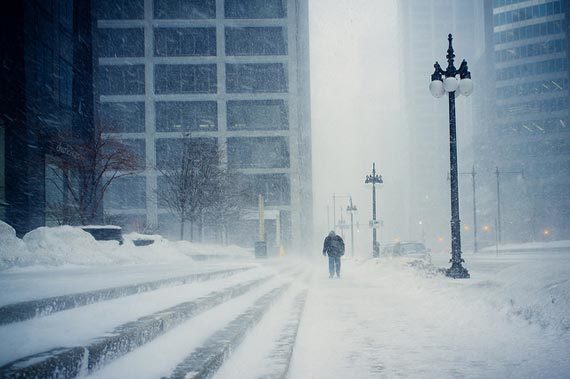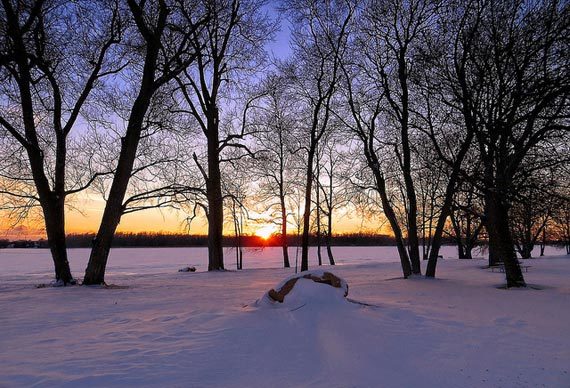In this article on photography tips for solving the photo doldrums, we’ll cover two more of water’s cold season photo ops: snow scenes and snow storms.
Snow Scenes
After the snow has just fallen, scenery can be beautiful, before the snow gets marred with footprints and tire tracks. Snow scenes are especially beautiful to see at sunrise and sunset when the snow takes on the colors from the sky. Just remember to compensate your meter reading + 1 to 1 1/2 stops.

Photo by Mark Robinson; ISO 400, f/8, 1/125-second exposure.
Snow Storms
Check the forecast for details, then you’ll know what your possibilities are. For example, if a large wet flake snow fall is predicted and wind will accompany it, forecast to drop off to calm before the snow stops, you might have the makings of an unusual snow scene. The wind will paste the wet falling snow to the exposed vertical surfaces and then, when it drops off to calm, allow the snow to come straight down onto every exposed horizontal surface. Walking through the scenery in the direction the wind was moving yields a snowscape that looks much like a black and white negative.
Self-Assignments For Above Photography Tips
Choose the projects that interest you most. Follow the photography tips conscientiously. Re-shoot when you aren’t satisfied. Do it until you are satisfied. It may take all your patience and passion. Your skills and eye will improve with the practice. Shoot in early and late light. Use a tripod as much as possible. Edit your results relentlessly. Pin small samples on the wall for a few days to study before making final prints for wall art.
1. Snow scenes. Get outside immediately after a fresh snowfall and locate a scene without tire tracks or footprints just at sunrise and shoot it. Do it with both a moderate wide angle and a moderate tele- focal length.
2. Snow storms. If you can get outside during a storm to a location in a park with evergreen trees or a large number of deciduous trees along the shore of a pond or lake, shoot with a slow shutter speed or else make a double exposure of the scene: one exposure in focus, the other out of focus, for an unusual picture.

Photo by Jason Ross.
The photography tips listed in this six article set serve to underline a vital point: water is, indeed, an ideal photo subject! It’s almost everywhere and, in line with the seasons, it readily provides a nearly endless number of ways at almost any time to take fresh and interesting images for overcoming the photo doldrums. Let’s quickly recap the ways covered in which we covered photography tips for shooting water as the ideal photo subject for overcoming the photo doldrums:
- waves, waterscapes & waterfalls
- reflections, abstracts, splash, spray, foam, bubbles & puddles
- condensation, hail, mist & fog
- frost, ice, re-freeze & ‘tenacious grace’
- icy streams, freezing rain, icicles & snowflakes
- snow scenes & snow storms

Photo by Chris Sorge; ISO 100, f/4, 1/200-second exposure.
Remember, to tap its visual possibilities you just need to get past the barrier of familiarity. To do that, you need to take another look—and a bit more closely the second time.
About the Author:
John Maxymuik writes for ambienceimages dot net. He authored this article, which is one of a set of six on “Photography Tips For the Photo Doldrums” providing tips to break the grip of the photo doldrums using the ideal photo subject.
Go to full article: Photography Tips for Snow Scenes and Storms
What are your thoughts on this article? Join the discussion on Facebook
PictureCorrect subscribers can also learn more today with our #1 bestseller: The Photography Tutorial eBook
The post Photography Tips for Snow Scenes and Storms appeared first on PictureCorrect.